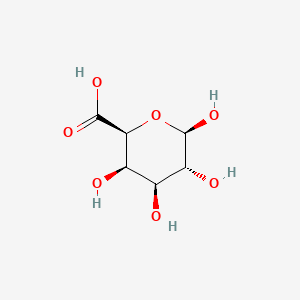



1. Calcium Pectinate
2. Methoxy Pectin
3. Methoxylpectin
4. Methoxypectin
5. Pectin, Methoxy
6. Pectinate, Calcium
7. Pectinate, Zinc
8. Pectinic Acid
9. Pectins
10. Zinc Pectinate
1. Beta-d-galactopyranuronic Acid
2. 18968-14-4
3. Beta-d-galacturonic Acid
4. (2s,3r,4s,5r,6r)-3,4,5,6-tetrahydroxyoxane-2-carboxylic Acid
5. 55ng3o9ndd
6. Oligogalacturonide
7. Unii-55ng3o9ndd
8. Schembl3407163
9. Chebi:47954
10. Galactopyranuronic Acid, Beta-d-
11. Zinc4097542
12. Db03652
13. .beta.-d-galactopyranuronic Acid
14. Galactopyranuronic Acid, .beta.-d-
15. C08348
16. Wurcs=2.0/1,1,0/[a2112a-1b_1-5]/1/
17. (2s,3r,4s,5r,6r)-3,4,5,6-tetrahydroxytetrahydro-2h-pyran-2-carboxylic Acid
18. (2s,3r,4s,5r,6r)-3,4,5,6-tetrahydroxytetrahydro-2h-pyran-2-carboxylicacid
| Molecular Weight | 194.14 g/mol |
|---|---|
| Molecular Formula | C6H10O7 |
| XLogP3 | -2.3 |
| Hydrogen Bond Donor Count | 5 |
| Hydrogen Bond Acceptor Count | 7 |
| Rotatable Bond Count | 1 |
| Exact Mass | 194.04265265 g/mol |
| Monoisotopic Mass | 194.04265265 g/mol |
| Topological Polar Surface Area | 127 Ų |
| Heavy Atom Count | 13 |
| Formal Charge | 0 |
| Complexity | 205 |
| Isotope Atom Count | 0 |
| Defined Atom Stereocenter Count | 5 |
| Undefined Atom Stereocenter Count | 0 |
| Defined Bond Stereocenter Count | 0 |
| Undefined Bond Stereocenter Count | 0 |
| Covalently Bonded Unit Count | 1 |
Pectin is used in food as a gelling agent and stabilizer. As a medical drug, it has obtained a great interest in its potential use as a source of dietary fiber, lipid, cholesterol, serum glucose and insulin level lowering effect, gastric emptying delay. Some recent studies have researched the possibility of using pectin for the formation of nanoparticles as a delivery vehicle of drugs.
Pectin increases viscosity and volume of stools which helps it to be used for constipation and diarrhea. It is reported as well to present lowering effects of different body components. This effect depends on the type of pectin which indicated that this effect is related to the composition of the correspondent pectin. Nonetheless, this data is still unclear and more studies need to be performed to conclude this effect of pectin.
Food Additives
Substances used in the processing or storage of foods or animal feed including ANTIOXIDANTS; FOOD PRESERVATIVES; FOOD COLORING AGENTS; FLAVORING AGENTS; ANTI-INFECTIVE AGENTS; EXCIPIENTS and other similarly used substances. Many of the same substances are used as PHARMACEUTIC AIDS. (See all compounds classified as Food Additives.)
A - Alimentary tract and metabolism
A07 - Antidiarrheals, intestinal antiinflammatory/antiinfective agents
A07B - Intestinal adsorbents
A07BC - Other intestinal adsorbents
A07BC01 - Pectin
Absorption
Pectin is not absorbed and it is not distributed in the body.
Route of Elimination
Pectin is completely excreted in the feces, including a small amount of trigalacturonic acid that can be found in the colon.
Volume of Distribution
Pharmacokinetic studies have not been performed as pectin is not absorbed.
Clearance
Pharmacokinetic studies have not been performed as pectin is not absorbed.
Pectin is depolymerized and de-esterified to a very small extent. It passes to the small intestine as a macromolecule and the majority of the pectin is eliminated unchanged.
Pharmacokinetic studies have not been performed as pectin is not absorbed.
Pectin is an adsorbent that binds to bacteria, toxins and other irritants in the intestinal mucosa. Pectin is able to decrease the pH in the intestinal lumen and provides a soothing effect on the irritated mucosa.
